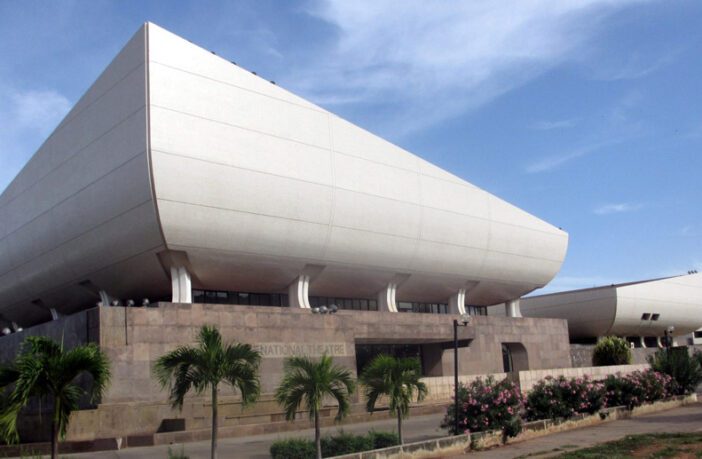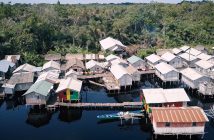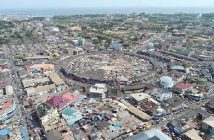The National Theatre of Ghana, which was opened in 1992 to influence the Theatre movement in Ghana by providing a multi-functional venue for concerts, dance, drama and musical performances, screen plays, exhibitions and special events, was built by the Chinese and offered as a gift to Ghana.
In Ghana, theatre as an artistic form has existed for centuries in the traditional dramatic expressions of society however, the National Theatre Movement (NTM) was conceived around the time of Ghana’s independence in 1957 to help remold the new nation’s cultural identity. The theatre is governed by the National Theatre Law 1991, PNDC Law 259.
The building houses the three resident companies of the National Dance Company, the National Symphony Orchestra, and the National Theatre Players. The theatre has a building area of 11,896 square metres (128,050 square feet) and is situated near the junction of the Independence Avenue and Liberia Road.
The building has a complicated construction moulding and novel exterior features.
When looked at from a distance, the whole structure looks like a giant ship or a seagull spreading its wings. The theatre which is located in the Victoriaborg district of Accra, Ghana, was then directed by Emeritus Prof. J.H. Nketia and was endorsed by Kwame Nkrumah in 1962. The company moved to the National Theatre in 1992 with Emeritus Prof. Mawere Opoku as their artistic director. Since then, the company has had other directors such as David Amoo (2006 – 2013), Mr. Nii-Tete Yartey (2013-2018) and Stephany Ursula Yamoah (2018 to present).
The National Dance Company is also known as “The Ghana Dance Ensemble.” The company was first established at the Institute of African Studies, University of Ghana as the first of its kind in 1962.
The Drama Company is one of the three Resident performing groups of the National Theatre of Ghana. It was established in August 1983 as a Model Repertory Troupe to facilitate teaching, research and experimentation at the University of Ghana, Legon. Then, it became the resident theatre for the theatre upon its completion in 1991.
The concert party, a well-loved theatre show which peaked in the early twentieth- century is crowd puller at the theatre. The concert party, although has its origins in Britain, was remodelled by Ghanaian artists and became a popular form of theatre in the 1950s and 1960s. Besides being turned into films, television series, photoplay, and cassettes, the concert party has been cherished for its theatre performances, often held at the national theatre. In fact, the medium was used for ‘theatre-for-development’ to discuss topics such as family planning, Aids and environmental protection, an idea originally pioneered by the Workers Brigades and Efua Sutherland.
The base is clad with square stone tiles and has an orthogonal form. The entrances and windows are carved out of the base. Making the base seem solid and being the entrance to a cave, rather than a theatre. This also creates an overhang by the entrance so theatregoers are sleided from bad weather. Above the base, there are three distinct white forms. These forms taper up from the centre, where the three forms meet, towards the outside. The walls of these forms are curved inwards and lifted just above the solid base, with glass in between them, making the base and white form more distinct and reinforcing the differences between them. These forms are covered in small white tiles to give the building its shape and colour.
It is the vision of the national theatre of Ghana, to be the beacon of the Performing Arts in Ghana. And its mission is to, To make the Performing Arts the anchor for the preservation, promotion, and development of Ghana culture.
Their values however are, Artistic Excellence, Partnership and Collaborations, Uniqueness of Ghanaian culture, Fiscal Responsibilities, Accessibility, Technology adaptation.
Now the national theatre of Ghana, has a new logo, that captures the visions and aspirations of the national theatre of Ghana. Rendered in the vibrant national colours of signal red, golden yellow, graphite black and a deep green, the symbol of horns are captured in a motion dance with the black star, (a throwback to duchamp’s kinetic art form). The simplicity of imagery and text has successfully illustrated how our horns, a feature of reenactment everywhere in traditional Ghana, embody the three main arms of the NTG; music, dance & drama. This logo is like none other and equally captures and compliments the unique strategic position of the national theatre of Ghana in our contemporary culture, our ‘Ghanacentricity’.
Over the years, the theatrical production in Ghana have operated in these areas through their activities( concert party, Wednesday theatre, among others).
Inspiring artistic experiences
Nurturing a strong administrative structure and fiscal responsibility
Building a healthy and committed staff
Engaging and enrich our communities
Broadening our audience base
Adopting technology for improved services
Establishing a communication environment
Pursuing an enhanced Theatre infrastructure
REFERENCES
1. Available online at, https://3rdworldarchitecture.wordpress.com/2018/02/04/national-theatre-of-ghana/
2. Available online at, http://www.nationaltheatre.gov.gh/about-us/





